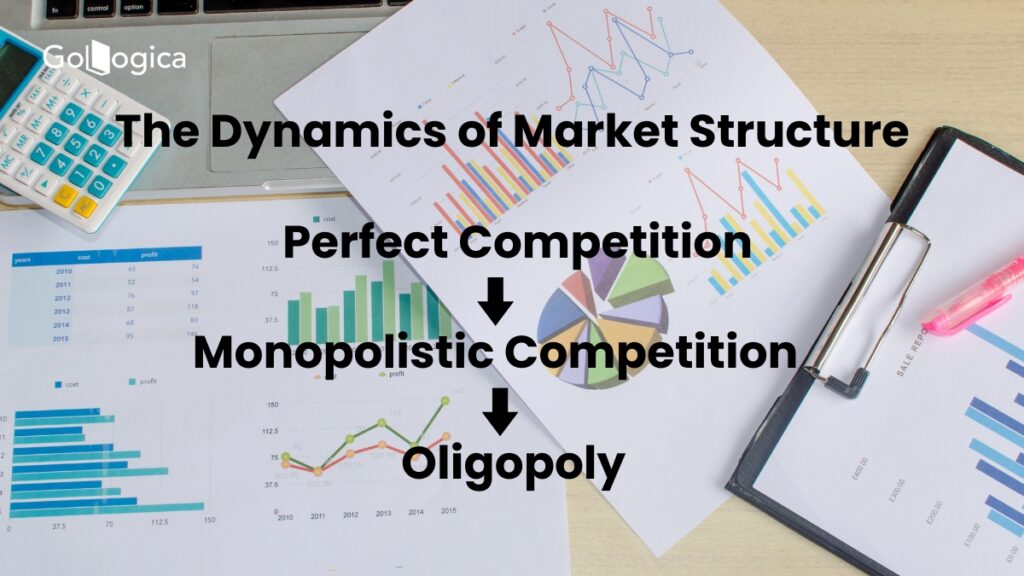
Table of content
- Introduction
- Types of Market Structures
- Perfect Competition
- Monopolistic Competition
- Oligopoly
- Features of Market Structures
- Number of Firms
- Barriers to Entry
- Product Differentiation
- Competition
- Pricing Power
- Fluctuations in Market Structure
- Entry and Exit
- Technological Advancements
- Changes in Consumer Preferences
- Government Regulations
- Importance of Understanding Market Structure
- Business Strategy
- Pricing Decisions
- Innovation
- Consumer Welfare
- conclusion
Introduction
Market structure is one of the determinants of how firms compete and operate in an economy. Market characteristics like number of firms, level of competition, pricing strategy, entry and exit barriers, etc., determine the nature of structure. it is important to firms, economists, and policymakers because it determines price, quantity produced, and market efficiency. There are different market structures, such as perfect competition, monopolistic competition, oligopoly, and monopoly, with their respective features. These structures define how firms do business and respond to change in the market. Changes in markets due to consumers’ needs, technological advancements, or regulatory measures continually alter market dynamics and structure over time. With the assistance of the general market, stakeholders are able to make informed choices and manoeuvre more effectively in the competitive market. The meaning, types, characteristics, and direction of market structure are discussed in this essay with the highlight placed on its relevance in today’s changing economic environment.

Types of Market Structures
It allows us to understand how different industries operate based on competition and product variety. There are three primary ones you need to know: perfect competition, monopolistic competition, and oligopoly.
There are different small businesses selling the same item in a perfect competition market. No firm has the ability to set the price, and every company possesses an equal amount of information regarding the market. The framework ensures fair prices and ease of entering or leaving the market.
Monopolistic competition is a situation in which many firms produce comparatively differentiated but not differentiated products. Each firm tries to be different, either by branding or otherwise. Owing to this, they actually have some kind of freedom to set their prices. Such a market exists in day-to-day businesses like clothes, eating houses, or cosmetics.
An oligopoly is a situation where there are a few huge companies that dominate the marketplace. They might or might not produce similar products and tend to restrict one another. Some of the examples include the telecommunications network, aviation, and automobile industries.
Unlock your online potential – refer this Digital Marketing Training to boost careers and businesses
Perfect Competition
Perfect competition is a market where multiple small enterprises sell standardized products and no company has control over the market pricing. In such a market, all companies are price takers since they have to consume the market price as it comes. This is due to the fact that the products provided are of the same kind, and buyers can switch easily from one seller to another without loss in value or quality.
There are some important characteristics of perfect competition: free entry and exit into the market, full information transparency, and numerous buyers and sellers. Because there is equal access to information for everybody and no considerable barriers for opening or closing a business, the market is very competitive.
Companies under perfect competition aim at cost minimization and efficiency since they cannot have any control over prices via branding or marketing. Profits are low in the long run since new companies come into the market when they notice opportunities, making supply high and prices low. Farm produce marketplaces and certain financial institutions are examples of perfect competition in practice.
Monopolistic Competition
Under this market structure, most companies function by producing similar but not identical products. In a perfectly competitive market where products are identical, in this case, firms attempt to be differentiated based on features such as branding, packaging, quality, or customer service. This product differentiation allows each firm some pricing power since consumers can choose between brands even though the price is set higher.
Free entry and exit are available in the market, which promotes ongoing competition and innovation. New firms can enter if they sense an opportunity to thrive, and old ones can exit if they are not profitable. Advertising contributes largely to this setup, as firms invest in projecting what sets their product apart.
Normal examples are local eateries, fashion companies, or cosmetics, where each company sells a unique experience. The consumer has an immense number of options, while companies enjoy the convenience of establishing customer loyalty. Nevertheless, excessive investments in marketing and branding often result in higher prices despite the same core product being offered by various sellers.
Oligopoly
Under a few giants in a market, competition is of a different kind. Rather than several small businesses, a few huge organizations control the majority of the market. These companies are very cognizant of one another’s plans, and thus, there is a high interdependence. When one company adjusts its price or introduces a new product, the others immediately respond to it, resulting in strategic management and even price wars.
Compared to other types of markets, here barriers to entry are relatively high. New companies have a problem entering because of the high capital outlay needed, entrenched brand loyalty, and regulatory issues. For this reason, incumbent companies have considerable control over the market and tend to set prices that are acceptable to them.
The goods sold can be greatly alike, such as in the case of gas, or differentiated, such as air travel or smartphones. Companies tend to use aggressive advertising and promotional strategies to keep customers. Although customers may enjoy quality and innovation, they are generally presented with fewer choices and possibly greater prices because there is less intense competition.
Features of Market Structures
They are defined by some unique features that describe the manner in which firms compete and conduct business. Some, like perfect competition, have many small firms, while others, like oligopoly, have several large firms. Another crucial feature is entry barriers, which group the simplicity or difficulty of the market to be entered by new firms. For certain markets, entry is open and easy, whereas for others it is closed with high barriers or government restrictions.
Product differentiation is another crucial factor. For some, all companies make the same product, and for others, companies attempt to differentiate themselves by having distinguishing features, brands, and services. Competition among companies differs with structure—highly competitive markets with many competitors and limited or no competitors. Finally is the question of pricing power. Firms have no or negligible price control in very competitive markets, while in less competitive markets, firms can price aggressively. They define the mode of operation of the market and affect business strategy and consumer demand.
Number of firms
In any market, the larger the number of firms taking the role of sellers, the more competitive the market will be.
Since there are so many firms, as in the example of perfect competition, no single firm can set the market price. All firms produce identical goods, and the buyers have easy mobility from one seller to another, and hence the market is extremely competitive. Whenever there are lots of companies under monopolistic competition, each company provides a difference to its product, and it may also be possible for each company to slightly differentiate its price. Where there are not lots of companies in one market, like an oligopoly, only a few huge companies are in control.
These companies rely on one another and would normally respond to one another’s pricing and marketing behaviour by colluding or competing. At one extreme is a monopoly in which there is a solefirm that serves the entire market under price and quantity control. Firm size and type determine firmly how companies behave and the manner customers are treated.
Barriers to Entry
In the other markets, new firms are challenged to enter or compete well because there are some hindrances. They include high entry barriers, intensive government regulation, brand loyalty, or access to superior technology. Where these exist, they restrict the number of firms that can enter the market, enabling existing firms to keep their stranglehold and stifle competition.
These barriers are common in sectors such as telecommunication, drugs, and energy, protecting established companies but preventing niche operators from expanding. Conversely, those with fewer of them enhance innovation, competitive pricing, and consumer choice.
These barriers will influence the functioning of a market by influencing prices, product availability, and the efficiency of the market. The more open or less difficult it is to enter a market, the more competitive and dynamic the market. When these barriers get too intense, they also lead to the formation of monopolies or less consumer well-being in the long term.
Product Differentiation
New firms in certain markets cannot initiate or compete successfully because of some barriers. They may be high entry barriers, state regulation, or brand loyalty or exposure to sophisticated technology. Where such barriers do exist, they restrict the number of firms that can enter the market so that existing firms can assume control and chase away competition.
These kinds of industries are like energy, pharmaceuticals, and telecommunications, which usually have such restrictions and shelter incumbent firms, making it difficult for small firms to expand. Other types of industries with fewer such restrictions promote innovation, low prices, and greater variety for customers.
These prohibitions have the ability to form the nature of how a market functions by influencing prices, supply of products, and general market efficiency. The more challenging it is to enter a market, generally, the more competitive and dynamic the market will be. When these prohibitions become very common, however, they can cause monopolies or decreased consumer welfare in the long run.
Begin your Agile journey with Certified Scrum Product Owner (CSPO) Certification Training and master the skills to drive product success in a Scrum environment
Competition
The intensity of competition among companies varies in different market structures. In dense markets, companies compete endlessly to acquire customers through enhanced price, quality, or innovation. Such vigorous competition benefits customers with more choices and reduced prices. With few companies, however, competition to overshadow one another may be insignificant, resulting in consistent prices but reduced choice. The level of competition relies on the number of buyers and sellers, product variation, and the simplicity with which new firms can enter. Greater market competition fosters efficiency, innovation, and better services in companies.
Pricing Power
The level to which the firm can determine the price of its commodity relies on the level of competition in the market. Under highly competitive arrangements like perfect competition, companies are price takers and have to keep the market price. Yet under less competitive markets like oligopoly or monopolistic competition, companies enjoy greater flexibility to price according to brand strength, product differentiation, or demand. With stiff barriers to entry or few substitutes to switch to, companies can sustain higher prices without changing customers. This price control is directly evident on profit margins and overall market trends in industries.
Changes in Market Structure
Shocks to market conditions can potentially alter the function of a market over the course of time. The alterations can come about due to technology, changes in consumer demand, growth in the economy, or due to legislative modifications. These advancements have the ability to alter the number of firms competing, price strategies, as well as the intensity of competition. For instance, with the new innovation making production cheaper, fewer firms will enter the market with more competition. On the other hand, consolidation by merger or shift in policy may lower the number of firms, and the market is concentrated. The changes impact the functioning of businesses so that they stay flexible and sensitive to remain in the industry.
Entry and Exit
One of the most distinctive features of market structure is the ease with which firms can enter and leave a market. It is easy for new firms to join markets such as perfect competition since they have minimal setup costs and fewer regulatory constraints. The outcome is more competition and less long-run profit. Conversely, markets like oligopolies or monopolies are those with high barriers to entry, i.e., plenty of money, tight regulations, or reputation value, and therefore new companies cannot compete. Simple exit also allows failing companies to leave without incurring much, but high exit barriers can force companies to stay afloat even in loss-generating situations.
Technological Innovations
technological innovations in tools, processes, and systems are the main causes of market functioning. They can push productivity upward, lower the cost of business, and enable new ways of delivering products and services. With greater efficiency, businesses can provide more value to consumers as well as a competitive edge. Most frequently, such progress enables new businesses to come into the marketplace, raising competition and displacing incumbent firms. It also changes consumer preferences, and companies are forced to remain ahead of the game where fashion is concerned. In the long term, this type of change can redefine the industry and cause the formation of new market forms to evolve.
Changes in Consumer Preferences
Shifting to what the consumer appreciates and demands can make a valuable contribution to market operations. As people change taste to keep up with trend, lifestyle, technology, or what the popular opinion holds, the companies have to adjust what they are offering to suit the new demand. It will generate additional competition because organisations invent to stay in the business. In other cases, whole industries can relocate or new markets are established because of the fluctuating preferences. As an example, the growing demand for environmental products has influenced a number of brands to go green. Failure by the businesses to respond to such changes would make them lose market share to others and more flexible businesses.
Government Regulations
The role of government regulations and legislation is quite decisive in market behaviours. These laws aim at offering healthy competition and consumer protection as well as stabilisation of the economy. They can as well control prices, the quality of a product, and the environmental policy, and they can even create or abolish firms in certain industries. As an example, high barriers to entry may be caused by excessive licensing fees or levies, and conversely, deregulation may stabilise markets, allowing more competition. The government can go as far as discouraging monopolies or triggering innovation by using subsidies and incentives. With a shift in regulation, firms must scramble to adjust their strategy, allowing them to stay within the new market paradigm and competitive.
Knowledge of Market Structure
Firms can make informed decisions and remain competitive through their awareness of how the market is structured. it determines prices, methods of production, marketing mechanisms, and how companies react to their competition. For instance, in competitive markets, companies can emphasise cost containment, while less competitive markets would maximise brand equity or innovativeness. this also facilitates the forecasting of consumer tendencies and opportunities and effectively managing threats. It gives stakeholders in the market as well as regulators insight into market performance, regulatory requirements, and economic influence. A clear concept generally allows for improved planning, more strategies, and profitable business development within an evolving economic framework.
Business Strategy
A satisfactory and good business strategy is necessary in order to accomplish long-term success in any market structure. It allows companies to spot goals, make effective decisions, and make wise decisions for competitiveness. Companies can determine their strengths, target the right area, and become responsive to changes in the market if they possess an ideal strategy. It allows companies to distinguish themselves from others based on price, innovation, or services. A successful strategy in evolving markets provides guidance and alignment and allows companies to adapt and take advantage of new opportunities. Lastly, it stimulates growth, improves performance, and builds sustainability amidst a changing business environment.
Begin your data-driven journey with the Business Intelligence Master Program and unlock powerful insights for smarter business decisions
Pricing Decisions
The correct price on a product or service is a necessary part of any business strategy. Price decisions have immediate effects on a company’s revenues, profit margins, and competitiveness. Cost of production: cost of production, market demand, competition, and consumer sentiment also assist in setting prices. Companies are able to sell low when operating in highly competitive frameworks in an attempt to appeal to consumers, but in low-competitive systems, they are able to charge more. Having a well-thought-out pricing policy guarantees profitability while ensuring customer focus. It also allows businesses to position their brand in the right place and respond to changes in market conditions or consumer behaviour.
Innovation
To sustain the competition and keep up-to-date, new products, ideas, or processes have to be introduced to a business. Innovation helps businesses to rationalise, meet changing customer needs and perform in highly competitive environments. It may involve the creation of completely new products or the improvement of the ones that it currently possesses to provide more value. It assists firms to act swiftly in accordance with the patterns in the market, it is cost-effective, and it aids consumers. Even opens up new avenues/sources of earnings, wherein companies can develop in the due course of time. The fact is that in industries with a high rate of change, continuous innovation is most often the difference between success and failure and therefore one of the core elements of any strategy.
Consumer Welfare
The welfare is a key indicator of how well the economy serves its citizens. Consumer welfare refers to the joy and gain that people obtain from purchasing goods and services at reasonable prices. Consumers have more options, quality, and lower prices when markets are competitive. Consumer welfare also includes protection against hazardous or misleading products through regulation and standards. Good consumer welfare means businesses are fulfilling the needs of consumers efficiently and ethically. Practices like promoting openness, fairness in trade, and innovation all help enhance consumer welfare. Finally, an ideal market would focus on the interest and satisfaction of its consumers.
Conclusion
That is important for understanding the way firms function, price, and compete. Every form perfect competition, monopolistic competition, and oligopoly has its own characteristics, challenges, and benefits. Variables such as the number of enterprises, product differentiation, entry hurdles, and price power all influence market forces. Also, technology-driven fluctuations, consumer demand, and government policies regularly redefine these structures. For businesspeople and aspiring economists, having a solid understanding of assists them in making better business and policy choices. GoLogica provides training that is led by experts and empowers learners with profound knowledge of economic concepts, such as market structures, to succeed in the current competitive landscape.










